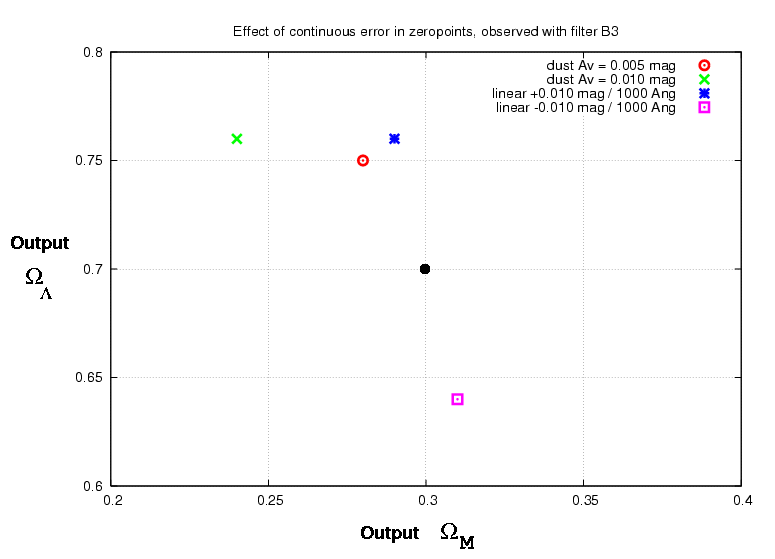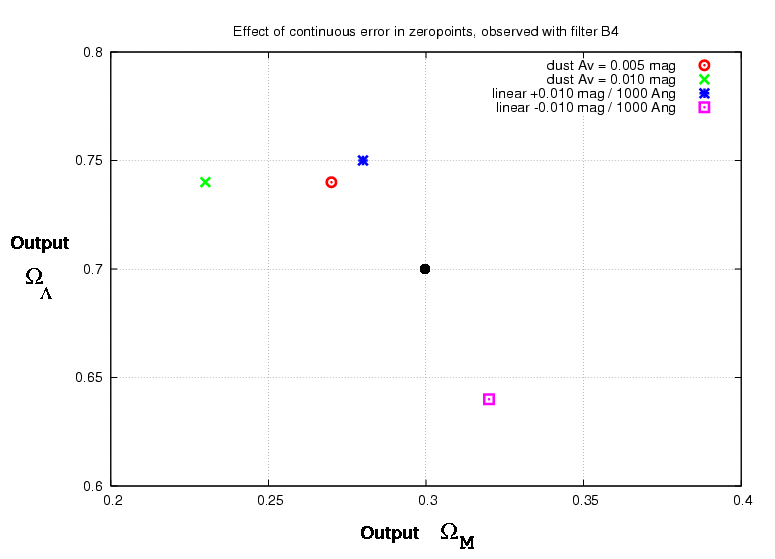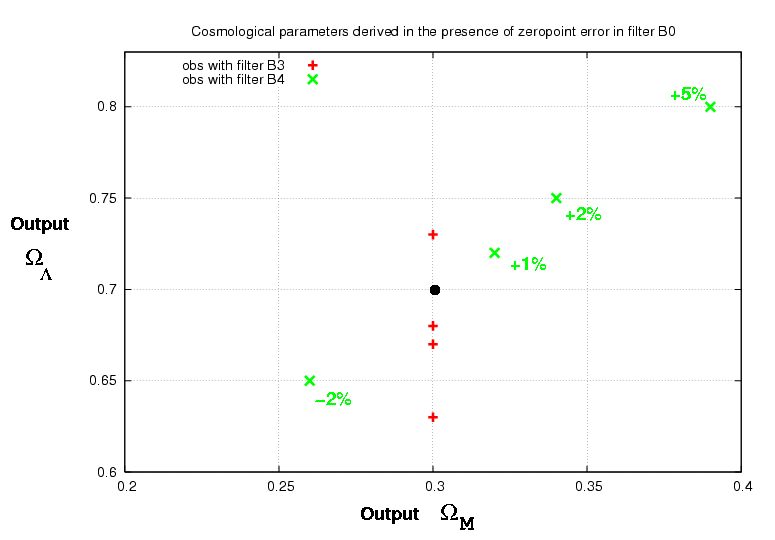
Ultra-quick summary: "the answer" (well, really just AN answer):

The goal is to find out quantitatively how small errrors in the zeropoints of the SNAP instrument would translate into errors in the cosmological parameters deduced from observations of SNe. I will describe a method of analysis which is somewhat different than the usual one, which I suggest may provide a useful secondary check on the usual methods.
For convenience, we assume that all Type Ia SNe are identical, and that we have a perfect model of their spectra at each point in their evolution. At a later time, we may incorporate a more realistic population of heterogeneous supernovae.
Now, suppose that there were no systematic errors in the photometric zeropoints of the SNAP instrument.
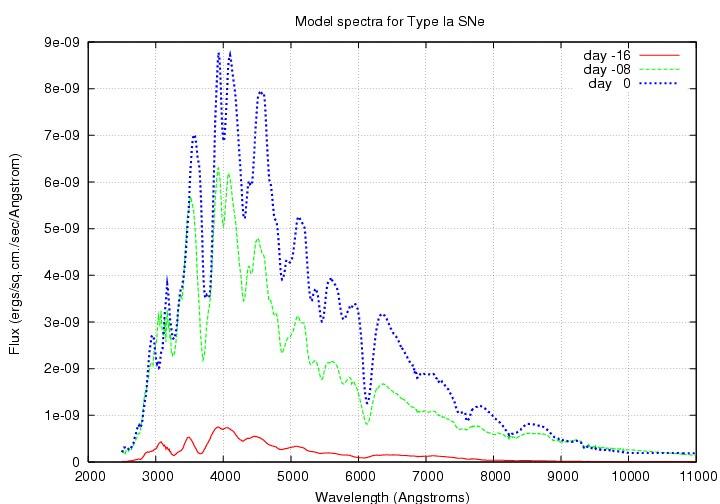
0.10, 0.11, 0.12, .. < ΩM < .. , 0.49, 0.50 0.40, 0.41, 0.42, .. < ΩΛ < .. , 0.89, 0.90
Given these inputs, we can create a set of light curves that the SNAP instrument would observe from supernovae at any particular redshift z. We do so in the following manner:
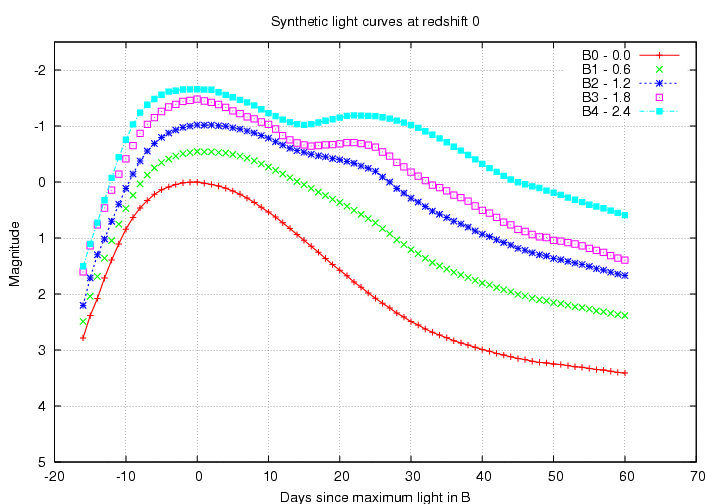
The input spectra cover the range 2500 to 10000 Angstroms. Over the redshift range z = 0.0 - 1.0, the SNAP passbands are shifted into the following ranges:
SNAP filter z = 0 z = 0.5 z = 1.0
--------------------------------------------------------
B0 3600 - 5500 2400 - 3670 1800 - 2750
B1 4200 - 6500 2800 - 4300 2100 - 3250
B2 4900 - 7500 3270 - 5000 2450 - 3750
B3 5800 - 8500 3870 - 5670 2900 - 4250
B4 6000 - 10000 4400 - 6670 3300 - 5000
--------------------------------------------------------
Filters B5, B6, B7, and B8 include wavelengths longer than the synthetic spectra in the rest frame, and so are disqualified from my initial study. Since filters B0, B1 and B2 are shifted out of the range of the input spectra at z = 1.0, I consider from here on the filters B3 and B4 only.
Next, we walk through all the input spectra and generate observed light curves for supernovae over the entire range of redshifts. For example, the B3 filter on SNAP (which is similar to the Johnson-Cousins I filter) will measure light curves like this:
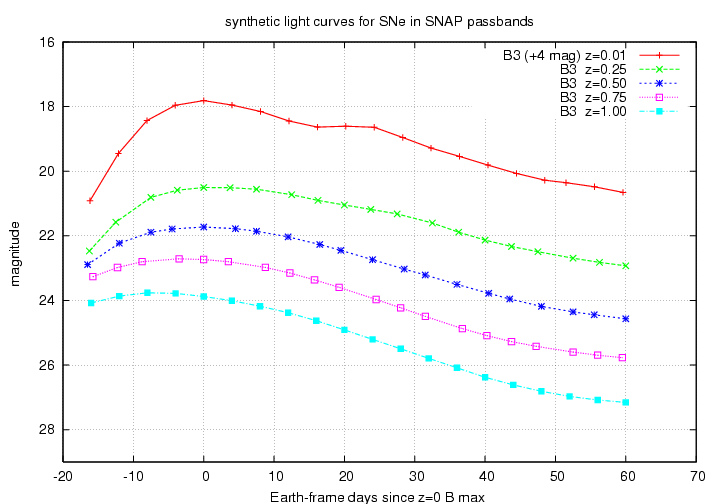
Note two different effects as the redshift increases:
One can examine these observed light curves to look for the time of maximum light and its magnitude. I sampled the simulated light curves at both 1-day and 4-day intervals and fit cubic splines to find the peak values.
At this point, the usual procedure involves comparing the light curves in one filter at high redshift to the light curves in a different filter at low redshift, using the spectra to calculate K-corrections. I will now follow a different path ....
Now, given a sample of Type Ia SNe over a range of redshifts, we can plot the redshift and observed peak magnitude in some particular SNAP filter to create an observed Hubble diagram.
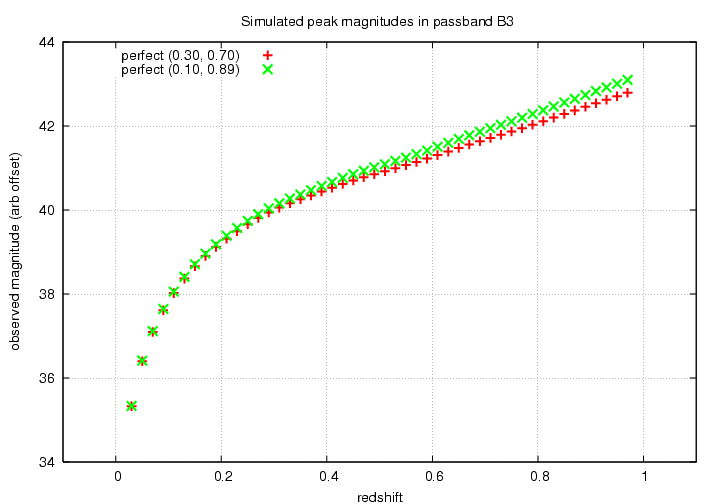
Both the shape and the location of the locus of peak magnitudes in this diagram tells us about the cosmological parameters ΩM, ΩΛ . The usual method of analysis concentrates on the location; that is, what is the peak magnitude of Type Ia SNe at a redshift of z=0.5, or z=0.7? This exact location along the vertical axis depends on several items which may contain systematic errors: the Hubble constant and the absolute flux calibration of the input spectra.
However, it is also possible to use the SHAPE of the locus, alone: measurements made by a single instrument which span a wide range of redshifts will indicate the proper cosmological parameters simply by the shape of the locus: one may shift the locus vertically by an arbitrary amount to find the best fit to a cosmological model. I will concentrate on this second method of attack. It is quite possible, of course, to follow both lines of analysis independently.
One way to treat zeropoint errors in the photometry is as perturbations to the passbands, which translate into perturbations to the supernova spectra. For example, the statement "the B-band zeropoint is 0.02 mag higher than it ought to be" is equivalent to the statement "the overall B passband has transmission values systematically too low by two percent," which can be simulated by pushing the input spectrum values UP by two percent in the region of the B0 filter.
So, we can evaluate the effect of zeropoint errors in the following manner:
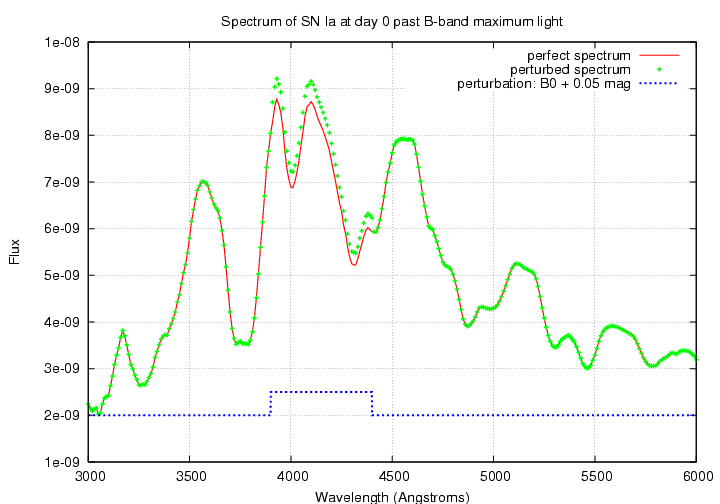
Now, unknowing astronomers on Earth will observe the perturbed Hubble diagram, but believe that it derives from perfect inputs. They will therefore compare the observed, perturbed peak magnitudes to their model, perfect peak magnitudes. We do the same:
The difference between the true input parameters and those inferred from the match of observations to theory yields the desired output: the quantitative bias caused by any particular type of zeropoint error.
I have thus far tested the following specific examples of systematic errors:
The results of simulations are shown in the tables below. I generated light curves for supernovae at redshifts 0.01, 0.03, 0.05, ..., 0.99. The noiseless simulations have a single event at each redshift; the simulations with noise place 5 events at each redshift, for a total of 250 SNe.
Recall that the input cosmology for the simulations had ΩM = 0.30, ΩΛ = 0.70. The entries in the table show the differences from these input values derived from fitting the perturbed observations of (z, peakmag) to the perfect model. For example, an entry in the table of
-0.02 +0.05
would mean that the best fit to the observations
had
ΩM = 0.28 (= 0.30 - 0.02),
ΩΛ = 0.75 (= 0.70 + 0.05).
|
|
||||
| case | ||||
| Δ ΩM | Δ ΩΛ | Δ ΩM | Δ ΩΛ | |
| A | 0.00 | 0.00 | 0.00 | 0.00 |
| C | 0.00 | 0.00 | 0.00 | 0.00 |
| changes to B0 only | ||||
| E | 0.00 | -0.02 | +0.02 | +0.02 |
| B | 0.00 | -0.03 | +0.04 | +0.05 |
| F | 0.00 | -0.07 | +0.09 | +0.10 |
| D | 0.00 | +0.03 | -0.04 | -0.05 |
| changes to B2 only | ||||
| G | -0.01 | +0.01 | -0.05 | -0.09 |
| H | +0.02 | 0.00 | +0.05 | +0.09 |
| changes to B4 only | ||||
| I | 0.00 | +0.01 | +0.02 | +0.07 |
| J | 0.00 | -0.01 | -0.02 | -0.07 |
| changes to several filters | ||||
| K | -0.01 | -0.01 | 0.00 | +0.01 |
| L | +0.03 | +0.04 | +0.02 | +0.05 |
| linear tilt across spectrum | ||||
| M | -0.01 | +0.06 | -0.02 | +0.05 |
| N | +0.01 | -0.06 | +0.02 | -0.06 |
| O | -0.01 | +0.01 | -0.01 | +0.02 |
| P | +0.01 | -0.01 | -0.01 | -0.02 |
| unrecognized extinction | ||||
| Q | -0.02 | +0.05 | -0.03 | +0.04 |
| R | -0.06 | +0.06 | -0.07 | +0.04 |
|
|
||||
| case | ||||
| Δ ΩM | Δ ΩΛ | Δ ΩM | Δ ΩΛ | |
| A | -0.01 | -0.01 | -0.01 | -0.01 |
| C | -0.01 | -0.01 | -0.01 | -0.01 |
| changes to B0 only | ||||
| E | -0.01 | -0.03 | +0.01 | +0.01 |
| B | -0.01 | -0.04 | +0.03 | +0.04 |
| F | -0.01 | -0.08 | +0.09 | +0.11 |
| D | -0.01 | +0.02 | -0.04 | -0.04 |
| changes to B2 only | ||||
| G | -0.02 | 0.00 | -0.06 | -0.10 |
| H | +0.01 | -0.01 | +0.04 | +0.08 |
| changes to B4 only | ||||
| I | 0.00 | +0.01 | +0.01 | +0.06 |
| J | -0.01 | -0.02 | -0.03 | -0.08 |
| changes to several filters | ||||
| K | -0.02 | -0.02 | 0.00 | +0.01 |
| L | +0.02 | +0.03 | +0.02 | +0.06 |
| linear tilt across spectrum | ||||
| M | -0.02 | +0.04 | -0.03 | +0.04 |
| N | 0.00 | -0.07 | +0.02 | -0.05 |
| O | -0.01 | +0.02 | -0.01 | +0.02 |
| P | 0.00 | -0.02 | 0.00 | -0.03 |
| unrecognized extinction | ||||
| Q | -0.03 | +0.04 | -0.03 | +0.04 |
| R | -0.07 | +0.05 | -0.07 | +0.04 |
The table below shows results for simulations in which a random error with RMS 0.03 mag is added to each measurement. Five events were generated at each redshift. As one might expect, the results are very similar to those for the noiseless simulation with the same 4-day interval.
|
|
||||
| case | ||||
| Δ ΩM | Δ ΩΛ | Δ ΩM | Δ ΩΛ | |
| A | -0.02 | -0.03 | -0.01 | -0.02 |
| C | -0.01 | -0.01 | -0.01 | -0.02 |
| changes to B0 only | ||||
| E | -0.01 | -0.03 | +0.01 | +0.01 |
| B | -0.01 | -0.04 | +0.03 | +0.04 |
| F | -0.01 | -0.08 | +0.08 | +0.09 |
| D | 0.00 | +0.04 | -0.04 | -0.04 |
| changes to B2 only | ||||
| G | -0.02 | 0.00 | -0.05 | -0.09 |
| H | +0.01 | -0.01 | +0.05 | +0.10 |
| changes to B4 only | ||||
| I | +0.01 | +0.03 | +0.02 | +0.08 |
| J | -0.03 | -0.05 | -0.03 | -0.08 |
| changes to several filters | ||||
| K | 0.00 | +0.02 | 0.00 | +0.02 |
| L | +0.01 | +0.01 | +0.01 | +0.03 |
| linear tilt across spectrum | ||||
| M | -0.02 | +0.05 | -0.02 | +0.05 |
| N | +0.01 | -0.05 | +0.02 | -0.05 |
| O | -0.02 | 0.00 | -0.02 | +0.01 |
| P | 0.00 | -0.03 | 0.00 | -0.03 |
| unrecognized extinction | ||||
| Q | -0.03 | +0.04 | -0.04 | +0.03 |
| R | -0.06 | +0.07 | -0.07 | +0.04 |
It may be simpler to grasp the general idea by looking at a graphical representation of subsets of the data. For example, suppose that there are errors only in the zeropoint of SNAP filter B0.

Note that the errors in ΩΛ go in different directions, depending on the filter used to observe the supernovae. This is not always the case.
The next figure shows the effects of +/- 2 percent errors in the zeropoints of different individual filters:
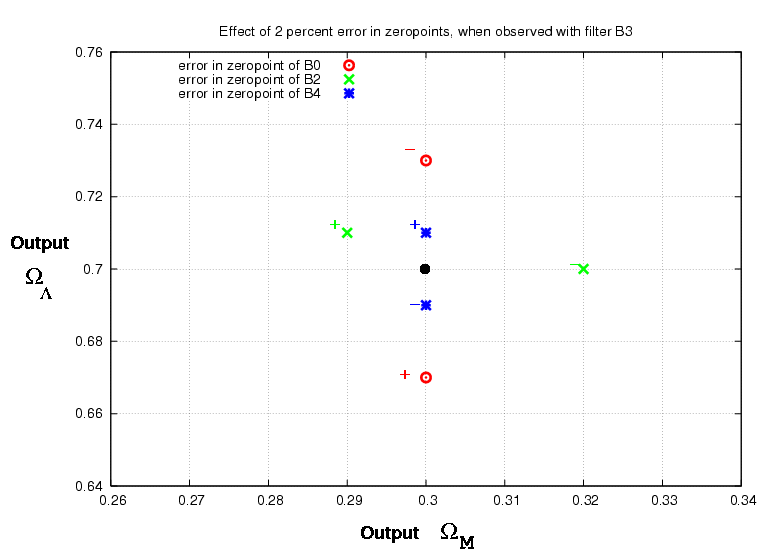
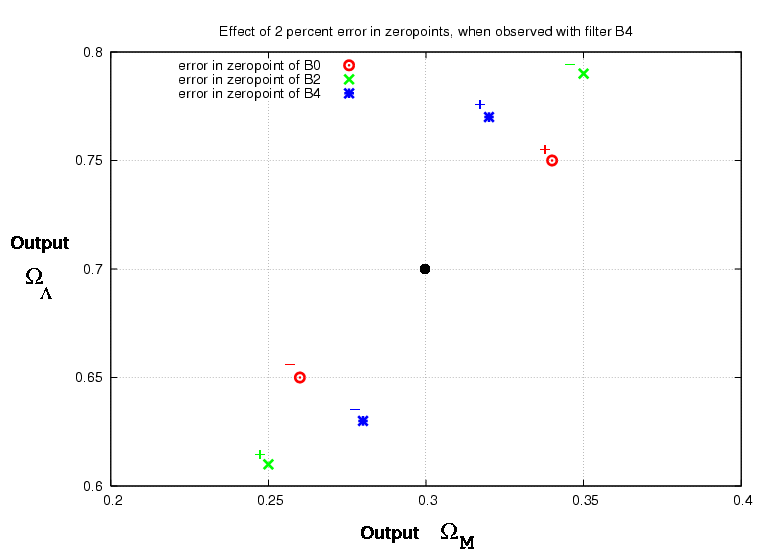
Another type of error could occur all the way across the optical and near-IR spectrum. I simulated both a simple linear tilt, and extinction due to dust, which has a slight curvature as a function of wavelength.
